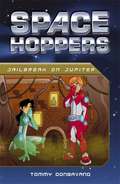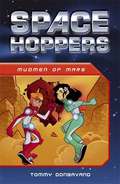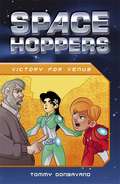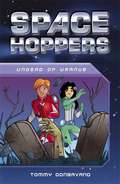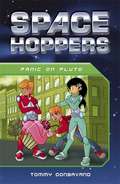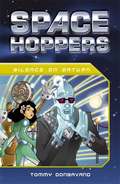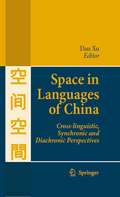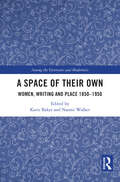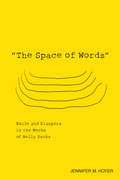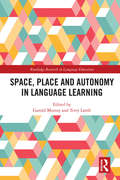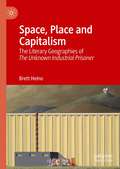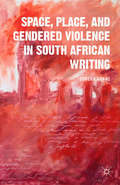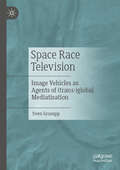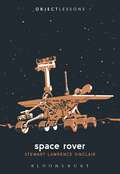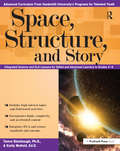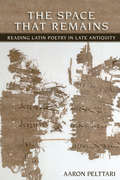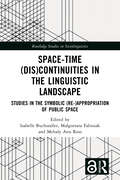- Table View
- List View
Space, Gender, and Memory in Middle English Romance: Architectures of Wonder in Melusine (The New Middle Ages)
by Jan ShawThis book offers a much-needed consideration of Melusine within medieval and contemporary theories of space, memory, and gender. The Middle English Melusine offers a particularly rich source for such a study, as it presents the story of a powerful fairy/human woman who desires a full human life—and death—within a literary tradition that is more friendly to women’s agency than its continental counterparts. After establishing a “textual habitus of wonder,” Jan Shaw explores the tale in relation to a range of Middle English traditions including love and marriage, the spatial practices of women, the operation of individual and collective memory, and the legacies of patrimony. Melusine emerges as a complex figure, representing a multifaceted feminine subject that furthers our understanding of Middle English women’s sense of self in the world.
Space Hoppers: Silence on Saturn (PDF)
by Tommy DonbavandSpace Hoppers is a brand new series of hilarious sci-fi fiction from popular author, Tommy Donbavand.
Space in Languages of China: Cross-linguistic, Synchronic and Diachronic Perspectives
by Dan XuSpace has long been a popular topic in linguistic research. Numerous books on the subject have been published over the past decade. However, none of these books were based on linguistic data from Chinese and expressions of space in Chinese have been largely neglected in past research. In this volume, not only Mandarin Chinese (the standard language) is investigated; several other dialects, as well as a minority language of China and Chinese Sign Language are studied. Cross-linguistic, synchronic and diachronic approaches are used to investigate phenomena related to space. The authors of this book present different points of view on the expression of space in language and related theoretical issues. As the contributing scholars argue, Chinese shares many common features with other languages, but also presents some particular properties. Space is a topic that is both classical and modern, of enduring interest. These studies of space give insight into not only general linguistics but also other domains such as anthropology and psychology.
The Space of Joy
by John FullerThe Space of Joy is a sequence of poems that recounts the endless desire for love (and the failures and compromises that accompany that desire) in a number of writers and musicians who fatally prioritise their art. It begins with Petrarch, who created great lyric poetry out of an impossible infatuation, and moves through Coleridge's self-induced guilt within domestic happiness, Matthew Arnold's disbelief in mutual love, Brahm's self-delusion and the complexities of Wallace Stevens's marriage. It so happens that both Brahms and Arnold found themselves contemplating their art and their lives in the small Swiss town of Thun, and it is Thun that provides the setting for the wonderful concluding poem of this collection in which Fuller thinks back to his own boyood and his parents' marriage. If there is any resolution in this sequence of magnificently playful and thought-provoking poems, it is the conviction that while 'poetry may be the only heaven we have', it is life itself that must create the 'space of joy' which art wishes to celebrate.Shortlisted for the Costa Poetry Award.
A Space of Their Own: Women, Writing and Place 1850-1950 (Among the Victorians and Modernists)
by Katie Baker and Naomi WalkerThis collection explores how nineteenth and twentieth-century women writers incorporated the idea of ‘place’ into their writing. Whether writing from a specific location or focusing upon a particular geographical or imaginary place, women writers working between 1850 and 1950 valued ‘a space of their own’ in which to work. The period on which this collection focuses straddles two main areas of study, nineteenth century writing and early twentieth century/modernist writing, so it enables discussion of how ideas of space progressed alongside changes in styles of writing. It looks to the many ways women writers explored concepts of space and place and how they expressed these through their writings, for example how they interpreted both urban and rural landscapes and how they presented domestic spaces. A Space of Their Own will be of interest to those studying Victorian literature and modernist works as it covers a period of immense change for women’s rights in society. It is also not limited to just one type or definition of ‘space’. Therefore, it may also be of interest to academics outside of literature – for example, in gender studies, cultural geography, place writing and digital humanities.
A Space of Their Own: Women, Writing and Place 1850-1950 (Among the Victorians and Modernists)
This collection explores how nineteenth and twentieth-century women writers incorporated the idea of ‘place’ into their writing. Whether writing from a specific location or focusing upon a particular geographical or imaginary place, women writers working between 1850 and 1950 valued ‘a space of their own’ in which to work. The period on which this collection focuses straddles two main areas of study, nineteenth century writing and early twentieth century/modernist writing, so it enables discussion of how ideas of space progressed alongside changes in styles of writing. It looks to the many ways women writers explored concepts of space and place and how they expressed these through their writings, for example how they interpreted both urban and rural landscapes and how they presented domestic spaces. A Space of Their Own will be of interest to those studying Victorian literature and modernist works as it covers a period of immense change for women’s rights in society. It is also not limited to just one type or definition of ‘space’. Therefore, it may also be of interest to academics outside of literature – for example, in gender studies, cultural geography, place writing and digital humanities.
"The Space of Words": Exile and Diaspora in the Works of Nelly Sachs (Studies In German Literature Linguistics And Culture Ser. #Volume 144)
by Jennifer M. HoyerNelly Sachs (1891-1970) has long been regarded as one of the most significant Holocaust poets. Her conception of language and words as a landscape has been understood by scholars and critics as an exilic ersatz Heimat for the lost German homeland of a displaced poet. This reading, however, is based entirely on her postwar poems. Such an isolated approach to her complex body of work is increasingly historically problematic; it is also at odds with Sachs's generally cyclical poetic process. In "The Space of Words," Jennifer Hoyer offers the first sustained critical analysis of Sachs's largely unanalyzed prewar poetry and prose, as well as the first analysis that examines structural and thematic ties between the prewar works and the Nobel Prize-winning postwar poetry. Through close readings of both Sachs's prewar and postwar works, Hoyer reveals a diasporic rather than exilic conception of the landscape of language, a position of constant wandering rather than static longing for return. This diasporic poetics promotes the intellectual and linguistic power of the wanderer and opens new insights into Sachs's essential significance as a Holocaust poet and a twentieth-century German-Jewish writer wary of the link of literary language to geopolitics and the narrative of nations. Jennifer M. Hoyer is Assistant Professor of German at the University of Arkansas.
Space, Place and Autonomy in Language Learning (Routledge Research in Language Education)
by Garold Murray Terry LambThis book explores theories of space and place in relation to autonomy in language learning. Encompassing a wide range of linguistically and culturally diverse learning contexts, this edited collection brings together research papers from academics working in fourteen countries. In their studies, these researchers examine physical, virtual and metaphorical learning spaces from a wide range of theoretical and interdisciplinary perspectives (semiotic, ecological, complexity, human geography, linguistic landscapes, mediated discourse analysis, sociocultural, constructivist and social constructivist) and methodological approaches. The book traces its origins to the first-ever symposium on space, place and autonomy, which was held at the International Association of Applied Linguistics (AILA) 2014 World Congress in Brisbane. The final chapter, which presents a thematic analysis of the papers in this volume, discusses the implications for theory development, further enquiry, and pedagogical practice.
Space, Place and Autonomy in Language Learning (Routledge Research in Language Education)
This book explores theories of space and place in relation to autonomy in language learning. Encompassing a wide range of linguistically and culturally diverse learning contexts, this edited collection brings together research papers from academics working in fourteen countries. In their studies, these researchers examine physical, virtual and metaphorical learning spaces from a wide range of theoretical and interdisciplinary perspectives (semiotic, ecological, complexity, human geography, linguistic landscapes, mediated discourse analysis, sociocultural, constructivist and social constructivist) and methodological approaches. The book traces its origins to the first-ever symposium on space, place and autonomy, which was held at the International Association of Applied Linguistics (AILA) 2014 World Congress in Brisbane. The final chapter, which presents a thematic analysis of the papers in this volume, discusses the implications for theory development, further enquiry, and pedagogical practice.
Space, Place and Capitalism: The Literary Geographies of The Unknown Industrial Prisoner
by Brett HeinoThis book is an original contribution to literary geography and commentaries on the work of David Ireland. It plots the relationship between the spaces and places of 1970s Australian capitalism as it evolves through Ireland’s 1971 Miles Franklin prize-winning novel The Unknown Industrial Prisoner. In particular, the book theorises the relationship between space and place in literature through two highly innovative arguments: a focus on the spatial unconscious as a means to assess and track the spatiality of capitalism in the novel form; and the articulation of a regime of space through the perceived, conceived and lived constitution of space. Drawing together concepts from radical geography and structural Marxist literary theory, it explores the dominance of the regime of abstract space in the Australian context. The text also examines the nature and possibilities of place-based strategies of resistance, and concludes by suggesting opportunities for future research and plotting the ways in which The Unknown Industrial Prisoner continues to speak to contemporary Australia.
Space, Place, and Gendered Violence in South African Writing
by S. GunneExploring the relationship between space, place, and gendered violence as depicted in a range of South African writing, Gunne examines the social and political conditions of exceptionality during and after apartheid. Writers covered include: Hilda Bernstein, J.M. Coetzee, Achmat Dangor, Ruth First, Nadine Gordimer, and Antjie Krog.
Space, Place and Poetry in English and German, 1960–1975 (Geocriticism and Spatial Literary Studies)
by Nicola ThomasSpace, Place and Poetry in English and German, 1960-1975 examines the work of Paul Celan, J. H. Prynne, Derek Mahon, Sarah Kirsch, Edwin Morgan and Ernst Jandl, bringing together postwar English- and German-language poetry and criticism on the theme of space, place and landscape. Nicola Thomas highlights hitherto underexplored connections between a wide range of poets working across the two language areas, demonstrating that space and place are vital critical categories for understanding poetry of this period. Thomas’s analysis reveals weaknesses in existing critical taxonomies, arguing for the use of ‘late modernist’ as a category with cross-cultural relevance, and promotes methodological exchange between the Anglophone and German traditions of landscape, space and place oriented poetic criticism, to the benefit of both.
Space, Place and Poetry in English and German, 1960–1975 (Geocriticism and Spatial Literary Studies)
by Nicola ThomasSpace, Place and Poetry in English and German, 1960-1975 examines the work of Paul Celan, J. H. Prynne, Derek Mahon, Sarah Kirsch, Edwin Morgan and Ernst Jandl, bringing together postwar English- and German-language poetry and criticism on the theme of space, place and landscape. Nicola Thomas highlights hitherto underexplored connections between a wide range of poets working across the two language areas, demonstrating that space and place are vital critical categories for understanding poetry of this period. Thomas’s analysis reveals weaknesses in existing critical taxonomies, arguing for the use of ‘late modernist’ as a category with cross-cultural relevance, and promotes methodological exchange between the Anglophone and German traditions of landscape, space and place oriented poetic criticism, to the benefit of both.
Space Race Television: Image Vehicles as Agents of (trans-)global Mediatisation
by Sven GramppThis volume offers a media-theoretically oriented perspective on the Space Race. It analyzes feature films, documentaries, live television coverage, magazines, stamps, posters, ticker-tape parades. They visualized the Space Race in a specific way and circulated it transnationally from 'East' to 'West' and from 'West' to 'East' across the 'Iron Curtain'. It will be shown how reporting on the Space Race between 1955 and 1975 can be explained as a globalizing history of the intertwining of images during the Cold War.
Space Rover (Object Lessons)
by Prof. Stewart Lawrence SinclairObject Lessons is a series of short, beautifully designed books about the hidden lives of ordinary things.In 1971, the first lunar rover arrived on the moon. The design became an icon of American ingenuity and the adventurous spirit and vision many equated with the space race.Fifty years later, that vision feels like a nostalgic fantasy, but the lunar rover's legacy paved the way for Mars rovers like Sojourner, Curiosity, and Perseverance. Other rovers have made accessible the world's deepest caves and most remote tundra, extending our exploratory range without risking lives. Still others have been utilized for search and rescue missions or in clean up operations after disasters such as Chernobyl. For all these achievements, rovers embody not just our potential, but our limits. Examining rovers as they wander our terrestrial and celestial boundaries, we might better comprehend our place, and fate, in this universe. Object Lessons is published in partnership with an essay series in The Atlantic.
Space Rover (Object Lessons)
by Prof. Stewart Lawrence SinclairObject Lessons is a series of short, beautifully designed books about the hidden lives of ordinary things.In 1971, the first lunar rover arrived on the moon. The design became an icon of American ingenuity and the adventurous spirit and vision many equated with the space race.Fifty years later, that vision feels like a nostalgic fantasy, but the lunar rover's legacy paved the way for Mars rovers like Sojourner, Curiosity, and Perseverance. Other rovers have made accessible the world's deepest caves and most remote tundra, extending our exploratory range without risking lives. Still others have been utilized for search and rescue missions or in clean up operations after disasters such as Chernobyl. For all these achievements, rovers embody not just our potential, but our limits. Examining rovers as they wander our terrestrial and celestial boundaries, we might better comprehend our place, and fate, in this universe. Object Lessons is published in partnership with an essay series in The Atlantic.
Space, Structure, and Story: Integrated Science and ELA Lessons for Gifted and Advanced Learners in Grades 4-6
by Tamra Stambaugh Emily MofieldWinner of the 2017 NAGC Curriculum Studies Award Space, Structure, and Story integrates Earth and space science with science fiction and nonfiction texts, poetry, and art. This unit, developed by Vanderbilt University's Programs for Talented Youth, is aligned to the Common Core State Standards and Next Generation Science Standards. Students explore advanced science and ELA content through the lens of structure—its parts, purpose, and function. Mobius strips, the hero's journey, dystopian fiction, black holes, Einstein's relativity, stars, and moons are just a few of the captivating in-depth topics explored through accelerated content, engaging activities, and differentiated tasks. Ideal for gifted classrooms or gifted pull-out groups, the unit features poetry from Carl Sandburg, Henry Wadsworth Longfellow, and C. S. Lewis; art from M. C. Escher, Vincent Van Gogh, Claude Monet, and Salvador Dali; a novel study featuring A Wrinkle in Time by Madeleine L'Engle; short stories from Isaac Asimov and Ray Bradbury; speeches from President John F. Kennedy and President Barack Obama; and informational texts about gravity, orbits, and black holes. Grades 4-6
Space, Structure, and Story: Integrated Science and ELA Lessons for Gifted and Advanced Learners in Grades 4-6
by Tamra Stambaugh Emily MofieldWinner of the 2017 NAGC Curriculum Studies Award Space, Structure, and Story integrates Earth and space science with science fiction and nonfiction texts, poetry, and art. This unit, developed by Vanderbilt University's Programs for Talented Youth, is aligned to the Common Core State Standards and Next Generation Science Standards. Students explore advanced science and ELA content through the lens of structure—its parts, purpose, and function. Mobius strips, the hero's journey, dystopian fiction, black holes, Einstein's relativity, stars, and moons are just a few of the captivating in-depth topics explored through accelerated content, engaging activities, and differentiated tasks. Ideal for gifted classrooms or gifted pull-out groups, the unit features poetry from Carl Sandburg, Henry Wadsworth Longfellow, and C. S. Lewis; art from M. C. Escher, Vincent Van Gogh, Claude Monet, and Salvador Dali; a novel study featuring A Wrinkle in Time by Madeleine L'Engle; short stories from Isaac Asimov and Ray Bradbury; speeches from President John F. Kennedy and President Barack Obama; and informational texts about gravity, orbits, and black holes. Grades 4-6
The Space That Remains: Reading Latin Poetry in Late Antiquity (Cornell Studies in Classical Philology #64)
by Aaron PelttariIn The Space That Remains, Aaron Pelttari offers the first systematic study of the major fourth-century poets since Michael Robert's foundational The Jeweled Style. It is the first book to give equal attention to both Christian and Pagan poetry and the first to take seriously the issue of readership.As Pelttari shows, the period marked a turn towards forms of writing that privilege the reader's active involvement in shaping the meaning of the text. In the poetry of Ausonius, Claudian, and Prudentius we can see the increasing importance of distinctions between old and new, ancient and modern, forgotten and remembered. The strange traditionalism and verbalism of the day often concealed a desire for immediacy and presence. We can see these changes most clearly in the expectations placed upon readers. The space that remains is the space that the reader comes to inhabit, as would increasingly become the case in the literature of the Latin Middle Ages.
Space-Time: Studies in the Symbolic (Re-)appropriation of Public Space (Routledge Studies in Sociolinguistics)
by Isabelle Buchstaller, Małgorzata Fabiszak, and Melody Ann RossThis collection spotlights the diachronic dimensions of the linguistic landscape, the importance of exploring temporal dissonances in historical events in order to better understand semiotic, political, and social transformations across different communities over the last century.The volume seeks to expand the current borders of linguistic landscape (LL) research by situating the analysis of signs in the LL within their time–space organization, which has been understudied in existing scholarship. The book, featuring chapters from established and emerging scholars, argues that a focus on the historicity of the city text can reveal unique insights into the role of semiotic processes as precursors and support mechanisms for political and social changes. The collection is structured around different temporal clusters and geographic contexts across the globe where shorter and longer waves of politically driven resemioticization can be most sharply observed – post-colonial communities; post-communist societies; and recent and current sociopolitical upheavals. Taken together, the volume proposes a kaleidoscope view of the complex temporalities that underpin multimodal discourses in contested public spaces, offering new directions for LL research.This book will be of interest to students and scholars in sociolinguistics, discourse analysis, semiotics, visual anthropology, and political science.The Introduction and Chapter 8 of this book is freely available as a downloadable Open Access PDF at http://www.taylorfrancis.com under a Creative Commons Attribution-Non Commercial-No Derivatives (CC-BYNC-ND) 4.0 license.

